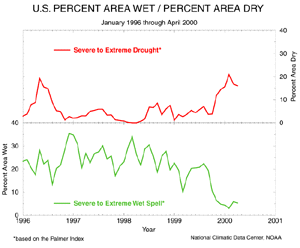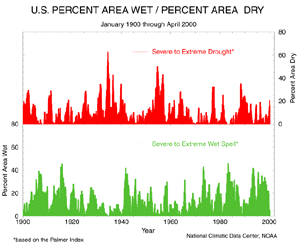The North American 500 mb Maps for April
The upper-air pattern remained active during April with several deep, storm-producing troughs crossing the country from west to east. Progressive Pacific-borne systems dominated the month with limited intrusions of cooler arctic air.
A mean upper-level ridge dominated the western half of the country and provided much warmer than normal temperatures from the western High Plains to the Pacific coast. A broad trough was present in the east where temperatures were cooler than normal in the Southeast and near normal from the Central Plains through the Northeast.
| The progressive storm track allowed for numerous frontal passages and several influxes of Gulf moisture which provided ample precipitation from the mid-Gulf region through the Northeast. Several high latitudinal troughs also provided normal to above normal precipitation amounts for the Pacific Northwest through the Northern Plains. The prevalent ridge over the West prohibited appreciable precipitation from the mid Mississippi River Valley through the Southwest.
|
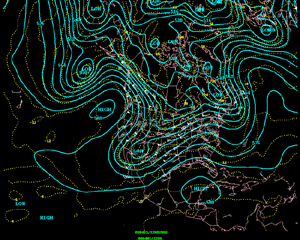
animation
|
Additional information on hydrometeorological analysis and forecasting can be found at the Hydrometeorological Prediction Center's Web Page. The principles behind the 500 mb flow are briefly explained Here.

 National Temperature - April
National Temperature - April
| The April 2000 monthly mean temperature averaged across the contiguous United States, based on preliminary data for the U.S. Historical Climate Network (USHCN), was warmer than normal and ranked as the 28th warmest April since 1895. Over 24% of the country was much warmer than normal while about two percent of the country was much cooler than normal. The actual April temperature values from 1895 through 2000 are available.
|
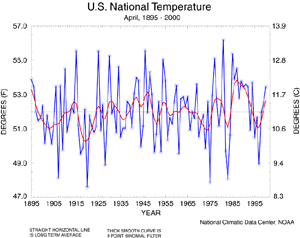
Larger image
|
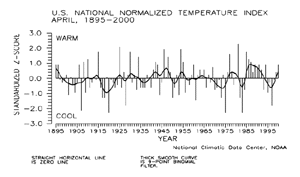
larger image
|
The preliminary national standardized temperature index ranked April 2000 as the 17th warmest April since 1895.
|
| The percent area of the contiguous U.S. much warmer than normal and much colder than normal for each month from May 1999 through April 2000 is depicted here. A shift to predominantly warmer than normal weather occurred in November 1999. This feature has persisted through the winter and spring months. April 2000 marked the first month since October 1999 that a portion of the country averaged well below normal.
|
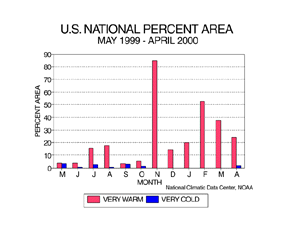
larger image
|
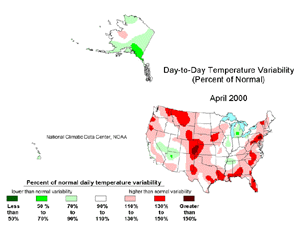
larger image
|
The map to the left, based on approximately 250 airport stations, shows how the day-to-day temperature variability for April 2000 compares to the 1961-1990 temperature variability normal. A U-shaped band of higher than normal variability stretched from the Northeast, along the east coast and Gulf coast, then up along the western Plains states and into the northern Rockies. Other areas of higher than normal variability occurred along western Oregon into northern and central California, southern Arizona, and much of Iowa. Pockets of below normal variability were found in the intermountain basin, the mid-Mississippi Valley, and southern Great Lakes. Much of the Hawaiian Islands and Alaska had below normal variability in April.
|
| The map to the right, based on approximately 250 airport stations, shows departures from the 1961-1990 normal temperatures for April 2000. Most of the country from the Rocky Mountains to the west coast averaged above normal. The Southeast U.S. averaged colder than normal, while most of the remaining stations east of the Rockies averaged near normal. Most of the Alaskan stations were above normal, with the greatest departures in the southwestern part of the state. The Hawaiian stations averaged slightly below normal.
|
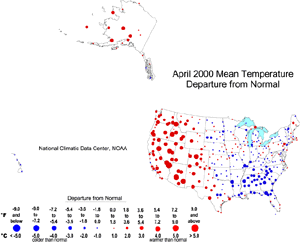
larger image
|
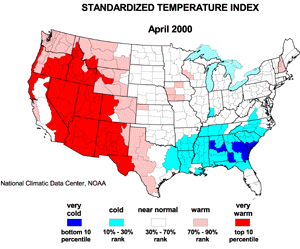
animation
|
The standardized temperature anomalies for April 2000 show the warm-West and cold-Southeast pattern seen in the plots of the other temperature indicators. The map animation provided to the left shows the geographical pattern of temperature anomalies for the last 12 months, compared to a base period of 1931-1990.
|

 National Precipitation - April
National Precipitation - April
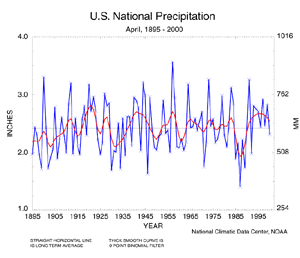
larger image
|
Based upon preliminary precipitation data, April 2000 ranked near the long-term mean. About five percent of the country was much wetter than normal while about five percent of the country was much drier than normal.
|
| The preliminary national standardized precipitation index also ranked April 2000 near the long-term mean.
|
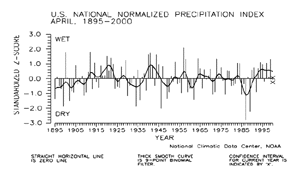
larger image
|
| The map to the right, based on approximately 250 First Order airport stations, shows April 2000 total precipitation as a departure from 1961-1990 station normals. Above-normal precipitation can be found in the Alaska panhandle and Aleutian chain, while most of the other Alaskan stations, as well as the Hawaiian stations, were drier than normal. On the mainland U.S., stations were predominantly wetter than normal from the Northeast to northern Alabama, with pockets of above normal precipitation in southern Florida and the West. Stations were drier than normal across much of the Southeast, the Mississippi Valley, and parts of the West. The Great Plains had areas of both extremes.
|
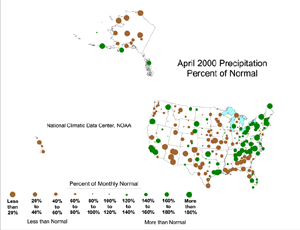
larger image
|
Long-term drought areal coverage (as measured by the Palmer Drought Index) decreased when compared to March, with about 16% of the country in severe to extreme drought during April. Several droughts in the past hundred years have covered a much larger area for a much longer time (see graph below right). The April 2000 drought is less than half the magnitude of the 1988 drought at its peak. The percent area of the country experiencing severe to extreme wetness dropped steadily from 23% in August 1999 to roughly five percent at the end of April.
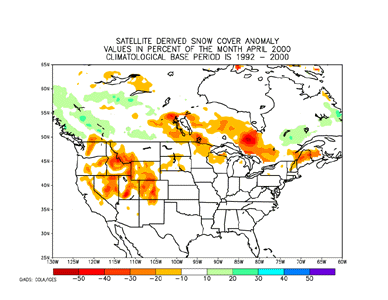
larger image
|
The snow cover anomaly map to the left reflects the general upper-level pattern across the U.S during April. The dominant ridge over the western half of the country prevented the normal accumulation of snowfall for the central and northern Rockies as well as the Washington and Oregon Cascades and the northern Sierras. Although most of the northeastern U.S. had greater than normal precipitation, normal to above normal temperatures allowed for little snowfall in the region.
|
An animation of daily snowcover for North America is available.

 Tornadoes - April and Year-to-date
Tornadoes - April and Year-to-date
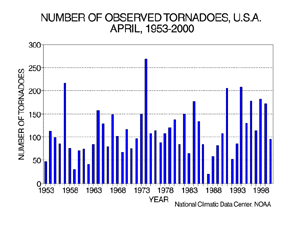
larger image
|
During April 2000, 95 tornadoes were documented across the contiguous United States. The 46-year average is 112. The most tornadoes observed in the April record was 269 in April 1974, while 20 tornadoes were observed in April 1987.
|
| For the year-to-date, January-April 2000, 240 tornadoes were documented across the contiguous United States. The 46-year average for the four-month period is 209. The most tornadoes observed in the January-April record was 467 in 1999, while 83 tornadoes were observed in the January-April period during 1987.
|
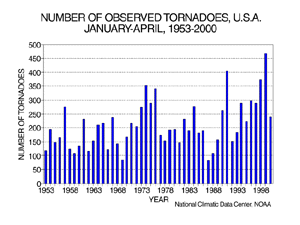
larger image
|
It should be pointed out that the preliminary tornado count is traditionally higher than the final count and that the tornado observations have generally improved with time as better observing practices and instrumentation (especially weather radar and satellites) were utilized.

 National Temperature - January-April 2000
National Temperature - January-April 2000
| The January-April 2000 mean temperature averaged across the contiguous United States, based on preliminary data for the U.S. Historical Climate Network (USHCN), ranked as the warmest such four-month period since 1895. Nearly 70% of the country was much warmer than normal while less than one percent of the country was much cooler than normal. The actual year-to-date data values from 1895 through 2000 are available. The persistent warmth of the last eleven months has resulted in record warm ranks for several combinations of months ending in April 2000. These include each of the nine periods from February-April 2000, January-April 2000, back to June 1999-April 2000. A few examples are illustrated in the table below.
|
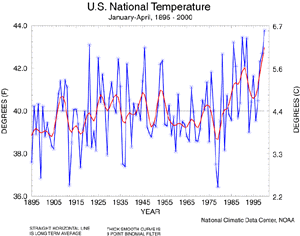
larger image
|
Record Warm Consecutive Month Periods
Ending in April 2000
| Warmest Period
|
Value (F)
|
2nd Warmest Period
|
Value (F)
|
| June 1999-April 2000
|
54.8°
|
June 1998-April 1999
|
54.7°
|
| September 1999-April 2000
|
48.2°
|
September 1998-April 1999
|
47.8°
|
| November 1999-April 2000
|
44.1°
|
November 1998-April 1999
|
42.8°
|
| January-April 2000
|
44.3°
|
January-April 1990
|
44.0°
|
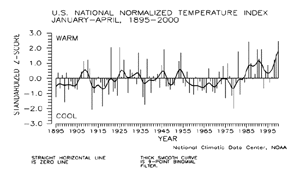
larger image
|
The preliminary national standardized temperature index ranked January-April 2000 as the warmest January-April since 1895. The smoothed temperature value for the January-April period has been above the long-term mean since 1982.
|
National Precipitation - January-April 2000
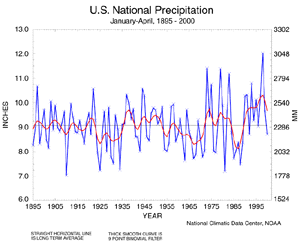
larger image
|
Based upon preliminary precipitation data, January-April 2000 ranked near the long-term mean. About eight percent of the country was much wetter than normal while about three percent of the country was much drier than normal.
|
| The preliminary national standardized precipitation index also ranked January-April 2000 near the long-term mean.
|
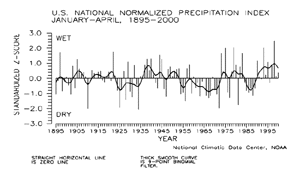
larger image
|

Current data are based on preliminary reports from River Forecast Center stations and First and Second Order airport stations obtained from the National Weather Service (NWS) Climate Prediction Center and real time Global Telecommunications System (GTS) monthly CLIMAT summaries. THE CURRENT DATA SHOULD BE USED WITH CAUTION. These preliminary data are useful for estimating how current anomalies compare to the historical record, however the actual values and rankings for the current year may change as the final data arrive at NCDC and are processed.
The following NCDC datasets are used for the historical U.S. data: the climate division drought database (TD-9640), and the hurricane datasets (TD-9636 and TD-9697). It should be noted that the climate division drought database consists of monthly data for 344 climate divisions in the contiguous United States. These divisional values are calculated from the 6000+ station Cooperative Observer network.


 National Temperature - April
National Temperature - April
 National Precipitation - April
National Precipitation - April
 Tornadoes - April and Year-to-date
Tornadoes - April and Year-to-date
 National Temperature - January-April 2000
National Temperature - January-April 2000
 NOAA's National Centers for Environmental Information
NOAA's National Centers for Environmental Information









